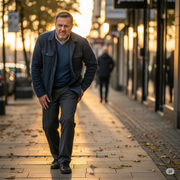Medial compartment knee osteoarthritis (OA) is strongly associated with an increased knee adduction moment (KAM), a key biomechanical marker for medial compartment loading. Recent evidence, highlighted by Uhlrich et al. (2025), demonstrates that a personalized approach to gait retraining is superior to generic protocols, leading to significant reductions in both KAM and pain, while improving function.
What is the Knee Adduction Moment (KAM)?

KAM is the primary driver of load distribution across the medial and lateral compartments of the knee during walking. A higher KAM increases the load on the medial compartment. It is directly associated with the presence, severity, and progression of medial knee OA (Mündermann et al., 2004). The goal of gait retraining is to implement strategies that effectively reduce this moment.
Key Personalized Gait Modification Strategies
Increase Step Width
Cue the patient to "walk with your feet slightly further apart." This shifts the ground reaction force vector closer to the center of the knee, reducing the KAM lever arm (Guo et al., 2007).
Toe-in Gait
Instruct a slight internal rotation of the foot ("turn your toes inward slightly"). This modification moves the knee joint center laterally, effectively reducing the KAM (Shull et al., 2013).
Contralateral Trunk Lean
A subtle lean of the trunk away from the affected side during stance phase. This shifts the body's center of mass, reducing the adduction moment at the knee (Hunt et al., 2010).
Medial Knee Thrust
Cue the patient to "create a window between your knees" as they walk. This active strategy directly counters varus thrust and helps to medially shift the knee over the foot.
Clinical Application: The Art of Personalization
- Assess, Don't Guess: Use observational gait analysis to identify the patient's dominant biomechanical fault. Not every patient needs the same cue.
- Utilize Real-Time Feedback: Employ mirrors, video recordings, or wearable sensors to provide immediate, actionable feedback. This is crucial for motor learning.
- Focus on One Cue at a Time: Avoid overwhelming the patient. Select the single most effective strategy identified during your assessment and focus on mastering it.
- Dosage and Progression: Start with short, focused practice intervals. Gradually increase duration and complexity by incorporating varied speeds, inclines, and surfaces.



